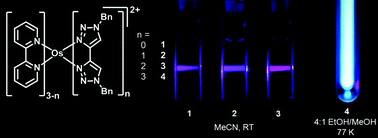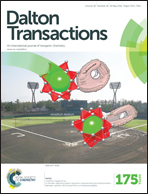Luminescent osmium(ii) bi-1,2,3-triazol-4-yl complexes: photophysical characterisation and application in light-emitting electrochemical cells†
Abstract
The series of osmium(II) complexes [Os(bpy)3−n(btz)n][PF6]2 (bpy = 2,2′-bipyridyl, btz = 1,1′-dibenzyl-4,4′-bi-1,2,3-triazolyl, 1n = 0, 2n = 1, 3n = 2, 4n = 3), have been prepared and characterised. The progressive replacement of bpy by btz leads to blue-shifted UV-visible electronic absorption spectra, indicative of btz perturbation of the successively destabilised bpy-centred LUMO. For 4, a dramatic blue-shift relative to the absorption profile for 3 is observed, indicative of the much higher energy LUMO of the btz ligand over that of bpy, mirroring previously reported data on analogous ruthenium(II) complexes. Unlike the previously reported ruthenium systems, heteroleptic complexes 2 and 3 display intense emission in the far-red/near-infrared (λmax = 724 and 713 nm respectively in aerated acetonitrile at RT) as a consequence of higher lying, and hence less thermally accessible, 3MC states. This assertion is supported by ground state DFT calculations which show that the dσ* orbitals of 1 to 4 are destabilised by between 0.60 and 0.79 eV relative to their Ru(II) analogues. The homoleptic complex 4 appears to display extremely weak room temperature emission, but on cooling to 77 K the complex exhibits highly intense blue emission with λmax 444 nm. As complexes 1 to 3 display room temperature luminescent emission and readily reversible Os(II)/(III) redox couples, light-emitting electrochemical cell (LEC) devices were fabricated. All LECs display electroluminescent emission in the deep-red/near-IR (λmax = 695 to 730 nm). Whilst devices based on 2 and 3 show inferior current density and luminance than LECs based on 1, the device utilising 3 shows the highest external quantum efficiency at 0.3%.


 Please wait while we load your content...
Please wait while we load your content...